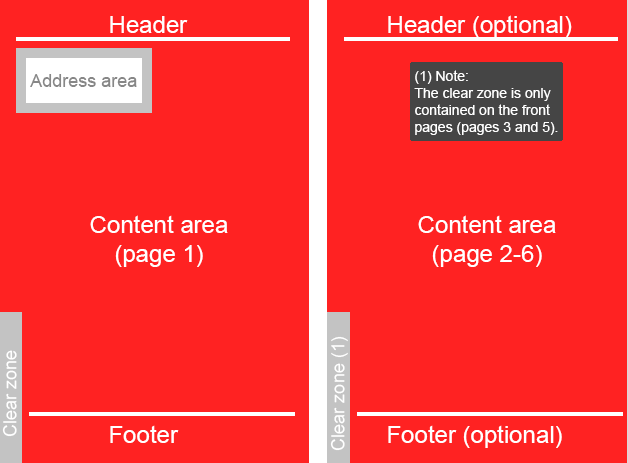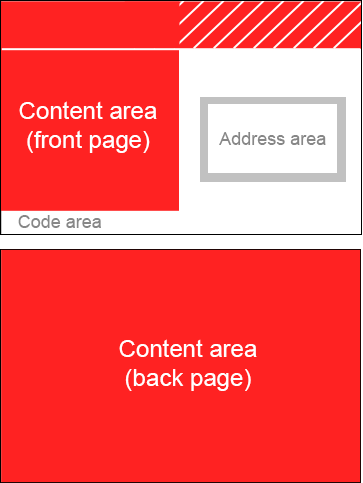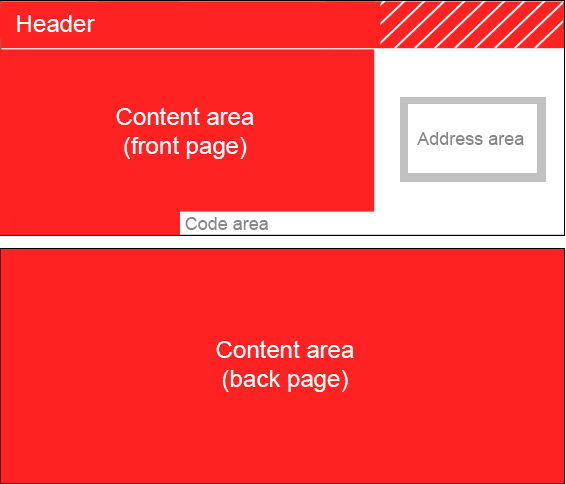 Creating print mailings
Creating print mailings
You can send a Print message to recipients in Germany only. See Information about print messages first for instructions and limitations.
To create a new message of type Print, follow these steps.
- Create a draft campaign, as explained in Creating and editing a Smart Campaign.
- Add desired nodesCampaign: Item that determines when a recipient passes through the campaign, and the actions that are executed for the recipient. With the help of "connections", you can link nodes to specify the process of your campaign. The arrow at the end of each connection always points to the next node and the associated action. to the campaign.
- Drag the Print node from the left action area to the working area on the right and click Edit content. The Edit content window opens.
- Follow the steps described in the Editing message content.
The editor lets you add content to a print mailing, edit existing content, initiate a test sending, or run a test print.
Print settings
To adjust print, layout and font settings for the print message, click the Settings button. The settings are described below according to the screen's tabs.
General
| Parameter | Description |
|---|---|
| Print settings | Available for letter format, not for postcards. |
| Print mode |
|
| Number of pages | Select up to six pages, depending on print mode. |
| Layout | |
| Space between texts and images | Creates a separation of text and image blocks to ensure readability of the letter. Default distance is 0.5 cm. Maximum is 5.0 cm. Do not use a value lower than 0.5 cm. |
| Inherit | Available for letter format only - not for postcards. |
| Header | Specify whether the header and footer content on the first page appears on the following pages. If inheritance is disabled, you can specify alternate content for the headers and footers on the following pages, or leave them blank. |
| Footer | |
Font settings
In the settings, open the Font settings tab to specify the fonts used.
| Parameter | Description |
|---|---|
| Headings | |
| Font type |
Enter multiple fonts separated by commas. If a font is not available, the next font listed is used. As a fallback, provide a generic font type, such as serif or sans-serif. |
| Color | Font colors for print mailings must be entered as CMYK color values; for example, cmyk(100%,0%,0%,0%). |
| Size | Enter font sizes for print mailings as point sizes (pt). |
| Line height | If you specify a fixed line height, enter a line height larger than the font size or lines of text will overlap. |
| Underline | Underline headings. |
| Bold | Bold headings. |
| Text | |
| Font type | Enter multiple fonts separated by commas. If a font is not available, the next font listed is used. As a fallback, provide a generic font type, such as serif or sans-serif. |
| Color | Font colors for print mailings must be entered as CMYK color values; for example, cmyk(100%,0%,0%,0%). |
| Size | Enter font sizes for print mailings as point sizes (pt). |
| Line height | Enter a line height larger than the font size, or lines of text will overlap. |
Additional fonts
If you would like to use additional fonts in your print mailings, these can be placed in the CMS for your client. To do this, you need the desired font along with the desired variations (for example bold, italic, ...) as a True Type Font (TTF). For more information, contact customer support.
Background images
In Settings, open the Background images tab to define a background image for individual pages of a letter, or the front and back sides of a postcard. Background images are printed borderless (if the uploaded image has the correct dimensions).
| Parameter | Description |
|---|---|
| Page 1-6 / address page / back page | |
| Image | Upload the desired background image. Graphics require a minimum resolution of 150 dpi. For optimal print quality, use 300 dpi.
|
| Width | You can specify the width of the image in cm. By default, this is determined from the number of pixels and the standard resolution of 300 dpi. If you want to keep the original size, leave this blank. If you specify a greater width than the original, the resolution is reduced accordingly. This also leads to reduced print quality. The minimum resolution is 150 dpi. If you specify a width that, after processing, produces a resolution less than this, then the maximum possible width at 150 dpi is used. The image cannot be made any larger. |
Letterhead
You can print the top edge of the letter or postcard with a letterhead. The letterhead can contain your company logo or a call to action. The size of the letterhead is limited, as the address area is below it. Place one or more content paragraphs in the letterhead area and insert the desired content (graphics or text).
Address area
The address area contains the sender and the recipient in machine-readable form. The size and position of this paragraph is fixed. This applies to postcards and letters. For the latter, the address needs to be visible in the window of the envelope.
| Parameter | Description |
|---|---|
| Layout | |
| Position of extra address line | Additional address information can be the name of the company or additional delivery instructions in the form of a c/o. If the mailing is primarily addressed to a business, select Additional address information on the first line. If the mailing is primarily addressed to an individual, then select Additional address information on the third line. |
| Position of salutation | Select the desired position for the salutation on the address area. |
Content area
The content area has content paragraphs available. To add a new content paragraph, click New: Content paragraph and select the desired type:
For the content area, additional pages or front and back sides are available depending on the format chosen for the mailing (Postcard DIN A6, Postcard DIN lang or Letter DIN A4).
Footer area
Place information such as contact details, bank account number, or company logos in the footer area. The footer has a fixed height and runs across the whole available width of the mailing. Place one or more content paragraphs and insert the desired content (graphics or text).
Printing a test message
To create a PDF that you can print for test purposes, click Letter DIN A4 (PDF), Postcard DIN A6 (PDF) or Postcard DIN lang (PDF).
The following image shows the content areas for the different formats:
Letter DIN A4

Postcard DIN A6

Postcard DIN lang

Color reproduction fidelity depends on the printer. Also, most printers cannot print borderless documents. If you want to do a test print of a postcard with an all-over background image, you may see a margin around the edges, and the size of the print is scaled to fit this margin.
Sending a test message
To test the dispatch process, send a test message. Test messages are sent using cheap dispatch. You generally receive a test letter within two working days.
- In the top toolbar in the editor, click Test message.
- In the Recipient list drop-down list, select a test list.
- In the Recipients drop-down list, select one or more recipients.
To create a new test recipient, click Create recipient and enter the necessary recipient data. Then click Submit.
- To send the test message, click Send by post.